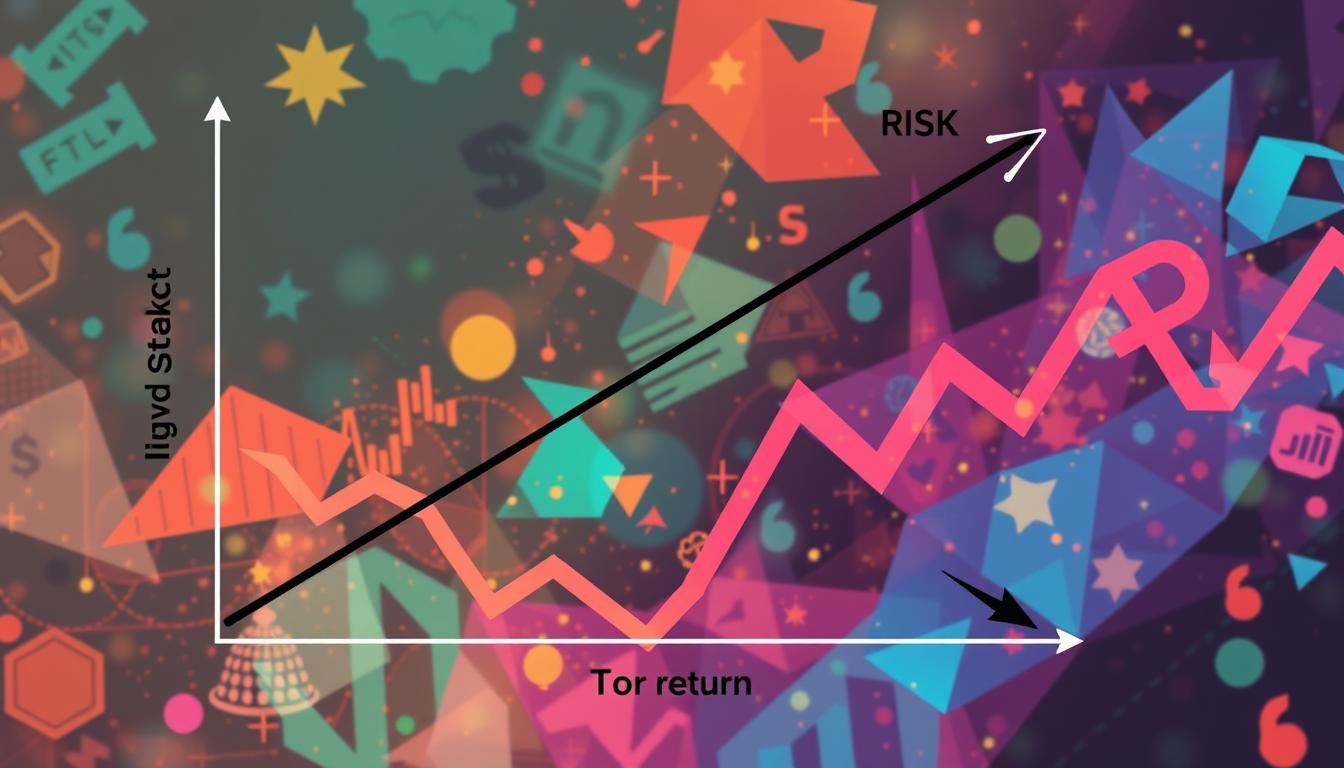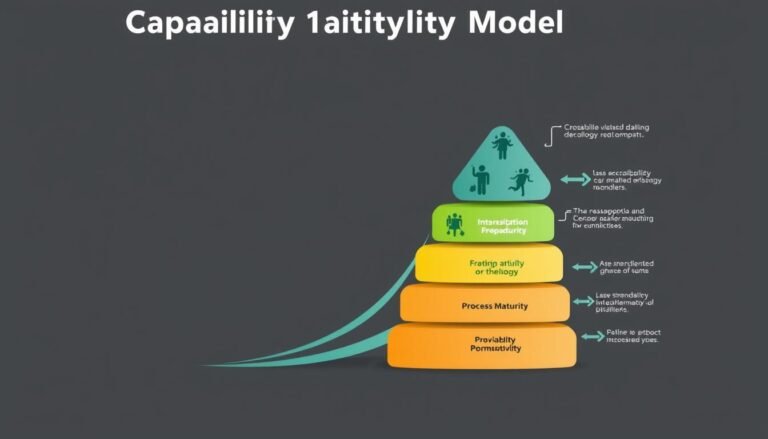Understanding the Risk-Return Tradeoff Principle
Have you ever thought about why some investors make a lot of money while others are scared to invest? This question gets at the heart of the Risk-Return Tradeoff. In investing, taking more risk often means you could get more money. This idea is key to how people plan their investments and handle financial risks.
Knowing about this tradeoff helps investors make better choices. It helps them match their investments with how much risk they can handle. By understanding risk and return, investors can make smart decisions. They can think about things like how long they plan to invest and the state of the market.
Key Takeaways
- The Risk-Return Tradeoff shows how potential returns and risks are linked.
- Taking more risk might lead to bigger rewards, so managing financial risk is important.
- It’s key to know how much risk you can handle when planning your investments.
- Time and market conditions affect how risks and returns work together.
- Spreading out your investments can help get better returns while reducing risk.
- Adjusting your investments to fit your long-term financial goals is important.
- Tools like Alpha, Beta, and Sharpe ratio help measure how well investments perform and their risk levels.
What is the Risk-Return Tradeoff?
The Risk-Return Tradeoff is key for anyone looking into investments. It says that the risk of an investment is linked to its possible return. Investors must weigh different risks to find investments that meet their financial goals. Knowing this tradeoff is vital for making smart choices in managing investments.
Definition and Importance
Higher risk usually means a better chance of getting higher returns. But, investments with lower risk often bring in less money. For example, a savings account is safe but doesn’t earn much. Stocks, however, carry more risk but could give you big returns over time.
This shows how important knowing your risk tolerance is in investing.
The Relationship Between Risk and Reward
Back in the 1950s and 60s, experts like Harry Markowitz and William Sharpe looked into this. Markowitz talked about how spreading out investments can help get better returns while managing risk. Sharpe then built on this with the Capital Asset Pricing Model (CAPM).
He said investors can find the best mix of risk and return by balancing their preferences. Surveys show how things like technology and the economy affect how people see risk and plan their investments.
Key Factors Influencing the Risk-Return Tradeoff
Understanding the risk-return tradeoff means looking at factors that affect investment choices. Risk tolerance and investment horizon are key. They shape how investors see potential gains and risks. The ability to replace lost funds also plays a big part in how much risk an investor can take.
Risk Tolerance and Investment Horizon
Risk tolerance is how much an investor can handle in investment ups and downs. It’s shaped by things like age, financial goals, and wealth. Young people might take more risks because they have time to recover from losses. Those near retirement want safer investments to keep their money safe.
The length of time you plan to invest is also important. A longer time frame means you can better handle market ups and downs. This could lead to better long-term results. Short-term investors usually pick safer options to avoid big losses.
Ability to Replace Lost Funds
Being able to replace lost funds adds complexity to investment choices. Those with steady jobs and savings can better handle losses. But, those living off their investments face big challenges if things go down.
Managing risk with techniques like diversifying and dollar-cost averaging can help. These methods spread out the risk across different types of investments.
Measuring Risk and Return in Investments
Investors use different metrics to check risk and return in their portfolios. It’s key to know these measures for smart investment choices. The Alpha Ratio, Beta Ratio, and Sharpe Ratio help gauge investment performance and risk.
Alpha Ratio: Evaluating Excess Returns
The Alpha Ratio looks at how a fund does against a benchmark index. A positive alpha means the fund beats the market, showing strong performance. A negative alpha means it lags behind. This tool helps spot managers who beat the market and check their strategy’s success.
Beta Ratio: Understanding Volatility
The Beta Ratio shows how an investment moves with the market. A beta over one means it swings more than the market, offering more risk and possibly bigger rewards. A beta under one means it’s less volatile. Investors use this to see how risky their investments are and plan better.
Sharpe Ratio: Assessing Risk-Adjusted Returns
The Sharpe Ratio looks at returns after considering the risk to get those returns. A ratio above one means returns outweigh the risk. A ratio below one means returns don’t make up for the risk. This helps investors pick investments wisely by looking at how well they balance risk and return.
Together, these ratios give a full picture of investment performance. They help with making smart choices about risk and return.
| Ratio | Purpose | Interpretation |
|---|---|---|
| Alpha Ratio | Evaluates excess returns relative to a benchmark | Positive indicates outperformance; negative suggests underperformance |
| Beta Ratio | Measures volatility compared to the market | Greater than 1 signifies higher risk; less than 1 indicates lower risk |
| Sharpe Ratio | Assesses risk-adjusted returns | Higher than 1 suggests favorable returns for risk taken |
Risk-Return Tradeoff in Portfolio Diversification
Portfolio diversification is key to managing risks in investments. By spreading investments across different types of assets, you can reduce the risk of losing money. This approach aims for better returns while keeping risks low.
Investors can use risk analysis to figure out how to spread their money. This helps them get the best results without taking too many risks.
Benefits of a Diversified Portfolio
A diversified portfolio offers many benefits, including:
- Reduced Volatility: Mixing different types of assets makes the portfolio less affected by market changes. This leads to more stable performance.
- Enhanced Risk Management: By using smart strategies, a portfolio can balance losses with gains from other areas.
- Improved Returns: Adding assets like private equity can increase returns and diversify the portfolio more.
- Systematic and Unsystematic Risk Control: Diversification helps manage both types of market risk, leading to better investment choices.
Balancing Risk to Achieve Desired Returns
To get the most from diversification, investors need to balance risk and expected returns. The way assets relate to each other is crucial in determining risk. Mixing assets that don’t move together much can greatly reduce risk. Callan’s 10-Year Capital Markets Assumptions show how different mixes can achieve the right level of diversification.
Here’s a table comparing major asset classes by expected returns and risks:
| Asset Class | Expected Return (%) | Standard Deviation (%) | Risk Type |
|---|---|---|---|
| U.S. Treasury Bonds | 3 | 4 | Low Risk |
| Corporate Bonds | 5 | 6 | Moderate Risk |
| Public Equities | 8 | 15 | High Risk |
| Private Equity | 12 | 20 | Very High Risk |
Understanding the risk-return tradeoff is key to making smart diversification choices. This approach helps improve returns while keeping risks in check.
Applying the Risk-Return Tradeoff in Investment Strategies
Investors have to make tough choices when planning their investments. They must balance between taking big risks and playing it safe, depending on their goals and how much risk they can handle. High-risk investments can lead to big gains but also big losses, making them best for those who can handle ups and downs. On the other hand, low-risk options are steadier but might not grow as much.
High-Risk vs. Low-Risk Investment Choices
Knowing the differences between high-risk and low-risk investments helps in making better choices. High-risk investments, like stocks, have offered about 10 percent annual returns. But, during tough times, like the 2008 financial crisis, stocks dropped by 57 percent, showing the risks involved.
- High-Risk Investments: Can lead to higher returns but come with a lot of ups and downs.
- Low-Risk Investments: Usually include corporate and Treasury bonds, giving around 6 percent and 5.5 percent returns each year.
- Cash Equivalents: Offer lower returns, like 3.5 percent from short-term Treasury bills, but are very safe.
Strategic Asset Allocation
Strategic asset allocation is key to mixing risks in a portfolio. It aims to find the best mix that meets an investor’s risk and return goals. By spreading investments across different types, like stocks, bonds, and cash, investors can reduce the impact of any one investment’s bad performance. This mix can make a portfolio more stable and increase returns.
| Investment Type | Average Annual Return | Risk Level |
|---|---|---|
| Stocks | ~10% | High |
| Corporate Bonds | ~6% | Medium |
| Treasury Bonds | ~5.5% | Low |
| Cash Equivalents | ~3.5% | Very Low |
Investors should think about how much risk they can take based on their situation. Things like age, financial duties, and long-term goals affect how much risk they can handle. A smart investment plan can change over time, helping with both growth and managing risks.
Common Misconceptions about the Risk-Return Tradeoff
The world of investing is often filled with misconceptions of risk. These misunderstandings lead investors to make poor choices. It’s key to know these misconceptions for smart risk assessment and investment decisions.
All Risky Investments Lead to High Returns
Many think that taking big risks means big rewards. But, this isn’t always true. The success of an investment depends on many things, like market changes and how well an asset does. Stocks, for example, can be risky but don’t always make money.
It’s important to know that risk can also mean big losses.
The Role of Market Conditions in Risk Assessment
Some believe market conditions don’t change how we assess risk. But, things like economic problems, interest rates, and global events can really affect investments. Even safe investments can drop a lot when the market is unstable.
Knowing how investment risk and market changes work helps investors deal with challenges better. A smart risk assessment looks at market conditions and your financial goals.
| Misconception | Fact |
|---|---|
| High-risk investments guarantee high returns | High risk can lead to high losses; balance is key. |
| The market is predictable | Market conditions fluctuate; past performance does not predict future results. |
| Only experts succeed in investing | Anyone can invest successfully with the right knowledge and approach. |
| Timing the market is essential for success | Time in the market matters more than timing. |
Conclusion
The Risk-Return Tradeoff is key in financial planning. It shows how risk and potential rewards are linked. Knowing this helps investors make smart choices that match their goals and how much risk they can handle.
Investments come with different levels of risk. Some, like government bonds, are safer. Others, like stocks and futures, can be more risky. Modern Portfolio Theory (MPT) uses math to help create portfolios that balance risk and returns.
This careful planning helps investors think about their risk tolerance and future earnings. It’s all about finding the right balance.
Understanding how risk and returns work together is crucial for good investment strategies. Tools like the Sharpe ratio and Roy’s safety-first criterion help measure risk and performance. With this knowledge, investors can make better choices, leading to stronger portfolios and better financial health.
Source Links
- Risk-Return Tradeoff: How the Investment Principle Works
- Risk and Return – Econlib
- What Does Risk Return Tradeoff Tell Investors?
- Risk and Return – Econlib
- Risk-Return Trade Off: Meaning, Importance & Uses | 5paisa
- D:\RESEARCH\Ross\FilterVolatility\Revision\FiltVol20.DVI
- The Risk-Return Tradeoff: Understanding Investment Goals for Long-Term Success
- Microsoft Word – CV_termstructure_riskreturn.doc
- Model Investing | Strategy Made Simple
- Risk Return Trade Off – Meaning, Example, and Calculation
- Risk-Return Tradeoff: Issues for Institutional Investors in 2023
- Risk: What It Means in Investing, How to Measure and Manage It
- Portfolio Risk and Return: Part I
- The Importance of Risk-Return Tradeoffs in Quantitative Finance
- Risk
- The Primary Risk of Investing: Permanent Loss of Capital
- 5 common misconceptions about investing risk and return
- Why Liquidity is Not Equal to Risk in Investing
- Investing in the Stock Market: Separating Fact from Myths Articles
- Is There a Positive Correlation Between Risk and Return?






